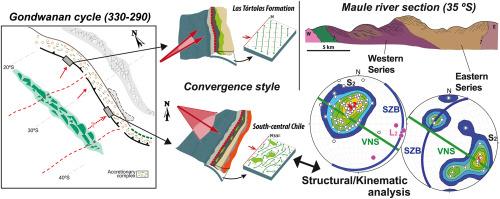基于智利北部和中南部增生杂岩构造分析的晚古生代西南冈瓦纳边缘辐合模式
IF 1.5
4区 地球科学
Q3 GEOSCIENCES, MULTIDISCIPLINARY
引用次数: 0
摘要
本文对智利沿海增生杂岩的辐合样式进行了综合分析,重点研究了Maule河剖面(35°S)的构造,以揭示晚古生代冈瓦纳西南边缘俯冲构造的复杂性。Maule河剖面是智利中部沿海增生杂岩的一部分,提供了对基底和锋面增生楔的结构配置的见解,并在本工作中与北部1000多公里的Chañaral msamuange进行了比较。构造分析表明,在收敛参数(俯冲带边界方位角、收敛方向、流动轨迹)上存在显著差异。本研究的目的是评估会聚样式对石炭系增生杂岩中这两个广泛分离的碎片在岩性、变质作用和构造特征上的差异的影响。马勒河剖面具有两个分异良好的区段:东系由低品位千层岩和石英岩组成;西系由含钠长石的泥质片岩、绿片岩和角闪岩组成,记录了中高压条件,温度低于500℃。东面石炭系岩浆弧及其基底在构造上与变质沉积楔并列。东部系列呈现相对的辐合构造:东部地区为东向构造,中西部地区为西向西北构造。而西系则表现出不同的构造模式,包括等斜褶皱和丰富的S-C构造。主片岩呈东-西-北-南方向,分别向南和向东倾斜。矿物和伸展线理走向以东西—北西—东南为主,低突向东、东南方向,显示由上至西西北方向的位移。通过对Maule河剖面构造数据的三维运动学模型分析,得出了一个三斜-单斜的逆压剪切带(俯冲通道及其影响带),其同轴分量为收缩分量(K = 5),简单剪切方向平行于俯冲带边界的倾角。颗粒流动轨迹(挤压方向)围绕N123E的辐合方向±24°波动±60°,与边缘方位角正交。在Chañaral地区,剪切带物质的辐合方向(N50-60E)和挤压轨迹的预测结果与智利中部海岸增生杂岩的结果相比,在变形带的边界处具有较低的螺距。晚古生代边缘构造的差异可能部分解释了北部(Chañaral地区)没有高压岩石的原因,尽管其他增生后过程,如构造侵蚀和块体旋转可能会加剧这些差异。此外,研究还认为,毛勒河剖面的双辐合可以用宽吸积棱镜中形成的楔前和楔后构造来解释。这一结果强调了在构造过程中进行三维运动学研究的重要性,以获得晚古生代整个俯冲系统活动和特征的完整构造图像。本文章由计算机程序翻译,如有差异,请以英文原文为准。

A convergence model for the SW Gondwana margin during the late Paleozoic based on the structural analysis of accretionary complexes in northern and south-central Chile
This study presents a comprehensive analysis of the convergence style in the accretionary complexes along the Chilean coast, focusing on the structural study of the Maule River section (35° S), to shed light on the complexity of the subductive southwestern Gondwana margin during the late Paleozoic. The Maule River section, part of the Coastal Accretionary Complex of Central Chile, provides insights into the structural configuration of the basal and frontal accretionary wedge, and is compared in this work with the Chañaral mélange, more than 1000 km to the north. The structural analysis reveals significant differences in the convergence parameters (subduction zone boundary azimuth, convergence direction, flow trajectories). The aim of this study is to assess the influence of convergence style on the differences in lithological, metamorphic, and structural characteristics between these two widely separated fragments of the Carboniferous accretionary complex.
The Maule River section is characterized by two well-differentiated sectors: the Eastern Series, comprising low-grade phyllites and quartzites, and the Western Series, consisting of albite-bearing pelitic schists, greenschists and amphibolites, recording medium-high pressure conditions and temperatures below 500 °C. To the east, the Carboniferous magmatic arc and its basement are tectonically juxtaposed to the metasedimentary wedge.
The Eastern Series exhibits structures with opposed vergences: eastward in the eastern area and west-northwestward in the central and western areas. In contrast, the Western Series shows different structural patterns, including isoclinal folds and abundant S-C structures. The main schistosity presents E-W to N-S directions dipping moderately to the south and east respectively. The mineral and stretching lineation trends mostly E-W to NW-SE with low plunges towards the east and southeast, indicating top-to-the-WNW displacement.
A 3D kinematic model applied to the structural data collected in the Maule river section results in a triclinic to monoclinic transpressive shear zone (subduction channel and its influence zone), with a constrictional coaxial component (K = 5) and with the simple shear direction acting parallel to the dip of the subduction zone boundary. The particle flow trajectories (extrusion direction) fluctuated ±60° around the convergence direction of N123E ±24°, orthogonal to the margin azimuth. In the Chañaral area, both the convergence direction (N50-60E) and the extrusion trajectories predicted for the materials in the shear zone, with a low pitch on the boundary of the deformation zone, contrast with the results obtained in the Coastal Accretionary Complex of Central Chile. The differences in the late Paleozoic margin configuration may partially explain the absence of high-pressure rocks in the north (Chañaral area), although other post-accretionary processes such as tectonic erosion and block rotations may accentuate these differences.
Besides, the study concludes that the Maule River section's double vergence can be explained by the pro-wedge and retro-wedge structure established in wide accretionary prisms. The results highlight the importance of performing 3D kinematic studies in tectonic mélanges to obtain a complete tectonic picture of the activity and characteristics of the entire subduction system during the late Paleozoic.
求助全文
通过发布文献求助,成功后即可免费获取论文全文。
去求助
来源期刊

Journal of South American Earth Sciences
地学-地球科学综合
CiteScore
3.70
自引率
22.20%
发文量
364
审稿时长
6-12 weeks
期刊介绍:
Papers must have a regional appeal and should present work of more than local significance. Research papers dealing with the regional geology of South American cratons and mobile belts, within the following research fields:
-Economic geology, metallogenesis and hydrocarbon genesis and reservoirs.
-Geophysics, geochemistry, volcanology, igneous and metamorphic petrology.
-Tectonics, neo- and seismotectonics and geodynamic modeling.
-Geomorphology, geological hazards, environmental geology, climate change in America and Antarctica, and soil research.
-Stratigraphy, sedimentology, structure and basin evolution.
-Paleontology, paleoecology, paleoclimatology and Quaternary geology.
New developments in already established regional projects and new initiatives dealing with the geology of the continent will be summarized and presented on a regular basis. Short notes, discussions, book reviews and conference and workshop reports will also be included when relevant.
 求助内容:
求助内容: 应助结果提醒方式:
应助结果提醒方式:


